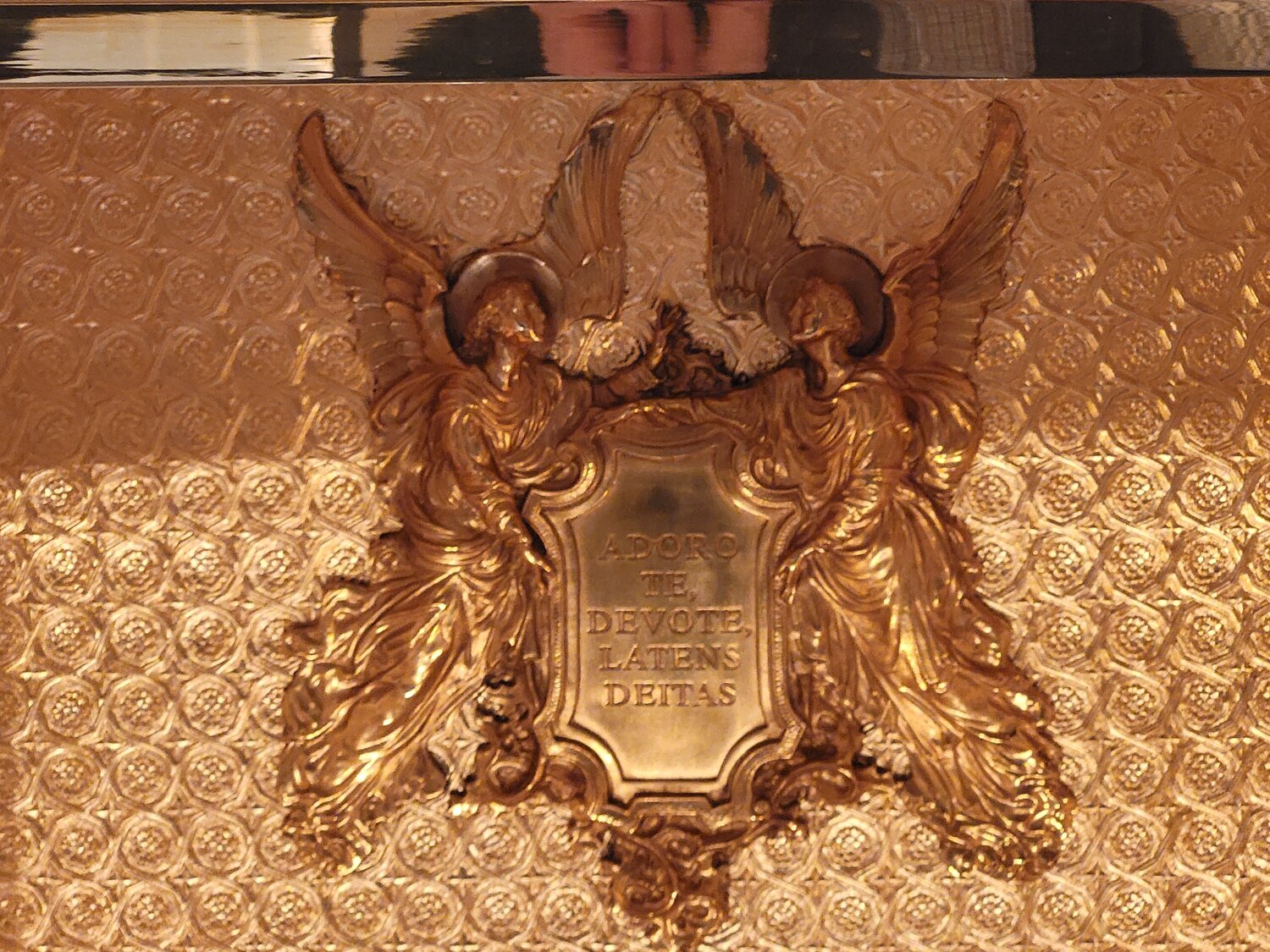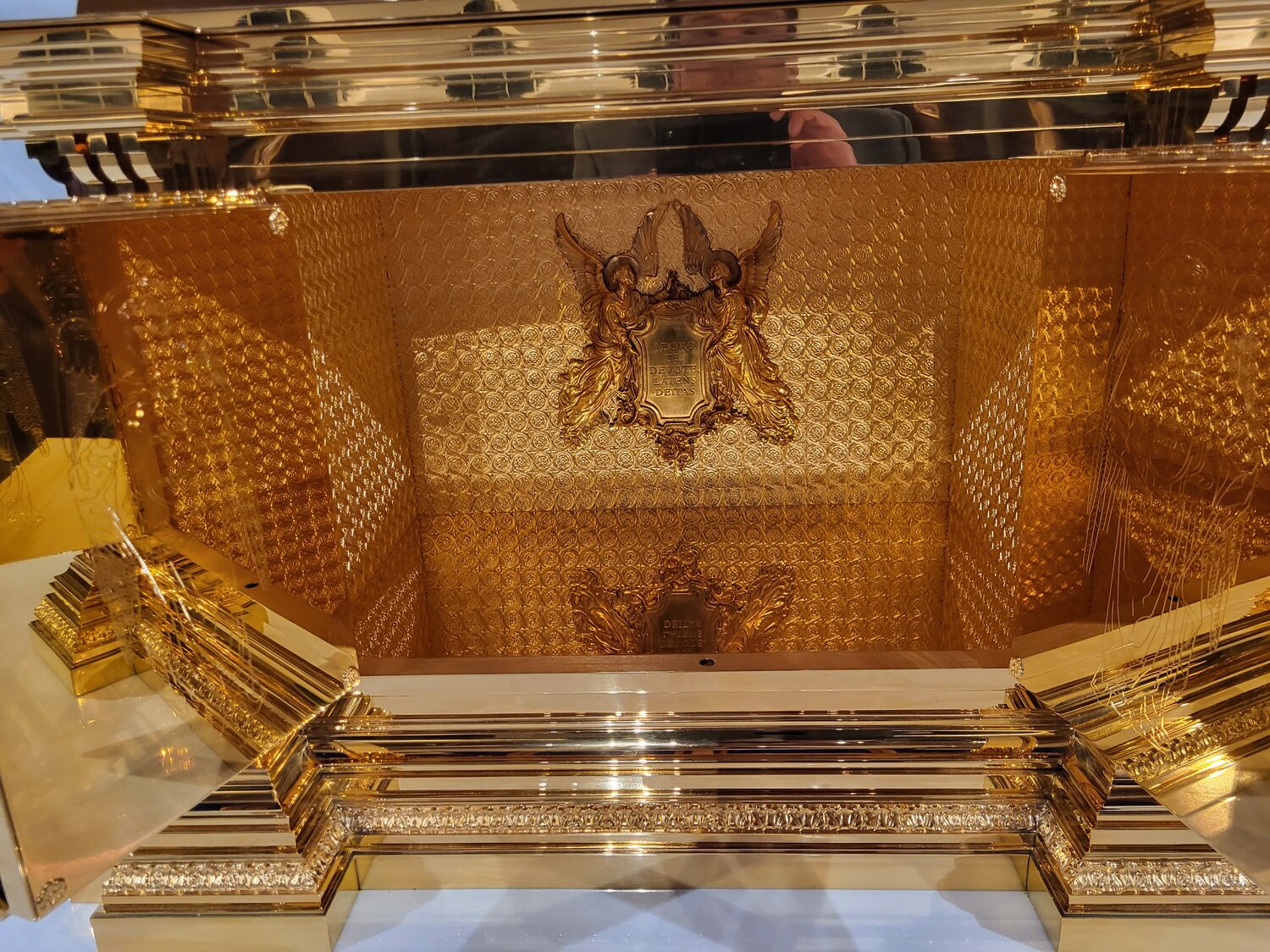Cathedral’s tabernacle reinforces oneness of the Eucharist, the Paschal Mystery

The tabernacle in the Cathedral of St. Joseph depicts the Annunciation of Mary, Ark of the New Covenant and Mother of the Church.
SCROLL THE ARROWS to see more photos.
This version, updated April 11, 2024, includes a description and photos of the inside of the tabernacle.
Like the Apostles who caught a glimpse of Jesus’s glory at his Transfiguration, people aren’t in much of hurry to leave the Cathedral of St. Joseph these days.
They tend to linger and take it all in.
“Because it’s beautiful,” said Bishop W. Shawn McKnight. “It’s the beauty of the art that moves people. It also instructs them and leads them into contemplation, which is exactly what liturgical art is supposed to do.”
Bishop McKnight was talking specifically about the Cathedral’s tabernacle, which was fashioned in Spain last year as part of a substantial renovation, expansion and renewal of the Cathedral, mother church of the diocese.
The purpose of the renovation was to enhance the half-century-old Cathedral’s beauty, functionality, capacity for hospitality and conduciveness to uniquely Catholic worship.
Artisans from Granda Liturgical Arts (granda.com) built the tabernacle according to established Church norms and the specifications submitted by Bishop McKnight, architectural consultant William Heyer, and the Cathedral renovation committee.
Gold-plated and adorned with blue trim enamel, the tabernacle evokes the Ark of the Covenant that was carried by the Israelites during their time in the desert, and later kept in the holiest room of God’s Temple.
Images of angels, also reminiscent of the Ark of the Covenant as described in the Book of Exodus, flank both sides of the tabernacle, each holding a vigil candle.
The doors on the front of the tabernacle are illuminated with a colorful depiction of the Annunciation — the moment the Virgin Mary agreed to become the mother of the Savior.
“Mary is the Ark of the New Covenant because she is the mother of our Lord, and she’s also the mother of the Church,” said Bishop McKnight. “That’s what’s being expressed here.”
He said the tabernacle, beautifully fashioned of solid, precious materials by seasoned liturgical artists, hints at the value of the treasure it holds — the Body and Blood, Soul and Divinity of Christ in the Holy Eucharist.
“Just as no disciple is greater than his teacher, no container is more precious than its contents,” the bishop noted.
From previous generations
The enameled panels on the doors depicting the Annunciation were made using an ancient technique involving the placing of finely ground colored glass dust onto a copper sheet, which is then fired in a kiln.
“This technique is called ‘pictorial enamel,’ because it resembles a painting,” said Lucas Viar Basterra, director of the Project Department for Granda Liturgical Arts.
It is particularly complicated because each ground glass color has a different melting temperature, and the colors change and transform in the kiln.
“So, the artist has to paint almost blind,” he noted.
Mr. Viar said a signature detail of a Granda tabernacle is the importance of the decoration and finish of the interior.
“This is a feature that our founder, Father Felix Granda, instilled into our workshop’s culture,” Mr. Viar stated.
“Not only because of the theological truth that what is important is who is inside, but also as a catechetical reminder for the priest and anyone else who opens the door of the Real Presence,” he said.
True to this dictum, the inside of the tabernacle is richly embellished with the same shimmering gold as the outside, but with a textured pattern resembling a gilded tapestry. A bas-relief image depicts two angels bearing a plaque with the words, “Adoro te, devote latens Deitas.”
This phrase is the first line of a hymn written by St. Thomas Aquinas. In English, the first verse proclaims:
“I worship thee devoutly, hidden deity,/What really lurks under these figures;/My whole heart submits itself to you,/Because looking at you all fails.”
Sacramental grace
Bishop McKnight pointed out how the Cathedral’s various artworks and liturgical fixtures, including the tabernacle, all tie together.
“It’s really all one piece, the whole sanctuary,” he said. “All the various parts relate to one another.”
The tabernacle and altar line up with the crucifix and the shimmering mosaic — depicting the Holy Trinity, the Apostles and the waters of Baptism — above the sanctuary, and with the stained-glass window at the other end of the center aisle, depicting Jesus feeding the 5,000.
These things instruct the faithful on many levels.
“When we’re talking about the Eucharist, we’re not just talking about the Sacrament and the Real Presence, but also the relationship between the Eucharist and the Church,” said Bishop McKnight.
He called to mind Pope St. John Paul II’s observation that “the Eucharist makes the Church and the Church makes the Eucharist.”
The bishop noted that the resplendent mosaic above the tabernacle illustrates the Paschal Mystery — the incarnation, passion, death and resurrection of Jesus — which is exactly what the Eucharist is.
“The Eucharist is the supreme Sacrament, because it is the only Sacrament that is the sacrament of the Paschal Mystery itself,” he stated.
“All the others are an application of the Paschal Mystery to the different moments of people’s lives, but the Eucharist IS the Paschal Mystery in sacramental form,” he said.
The rich symbolism throughout the mosaic points to all aspects of the Paschal Mystery — “with the hand of the Father, the crucified depiction of the Lord, the giving of the Holy Spirit — along with the Church, symbolized by the tree of life and a peacock, symbolizing the resurrection,” said Bishop McKnight.
“You also have 12 sheep, symbolizing the Twelve Apostles and therefore the foundation of the Church,” he noted.
The mosaic also depicts a river, tying Baptism to the Paschal Mystery, just as one level of the sanctuary flows directly into the nearby Baptistry, highlighting the unbreakable bond between the Eucharist and Baptism.
“And, of course, the ambry off to the side as the repository of the holy oils, invoking the work of the Holy Spirit,” the bishop added.
Present and accounted for
The placement of the tabernacle, the altar, the ambo, the cathedra, the presider’s chair and the “IHS” insignia over the people in the Cathedral all evoke Christ’s presence.
“The Real Presence is not only in the Blessed Sacrament but in our celebration of the Mass, in the ministers and the Church itself and in the proclamation of the Word of God,” he stated with emphasis.
“So artistically, we honor and mark the various presences of Christ — obviously, the tabernacle is manifesting our belief in the Real Presence — the substantial presence and the philosophical understanding,” he said.
“But the altar, in terms of the sacrifice, of the ACTION of the Mass — the Eucharist is ACTION,” he said.
“The ambo, from which the Word of God is proclaimed — it’s got to be noble and substantial.”
The chairs for the priests and deacons in the sanctuary point to Christ’s presence in them as they exercise their sacred duties.
“In the same way, presence of the bishop’s chair — the cathedra — points to the uniqueness of a cathedral, which is the bishop’s church,” he said.
“And we have over the main assembly the markings of the name of Christ, ‘IHS,’ which is the Body of Christ, speaking of the significance of the presence of Jesus among the Church,” the bishop stated.
“Starkly Catholic”
Bishop McKnight said the scale and beauty of the Cathedral — the bishop’s church, the mother church of the diocese — helps to “manifest the reality that our communion and our belonging to the Roman Catholic Church is dependent upon our being in communion with the local successor to the Apostles.”
“The Roman Catholic Church is defined as ‘the communion of churches, of bishops that are in communion with each other and under and in union with the Holy Father,” he said.
Bishop McKnight said that beyond being a symbol of Church unity, the renovated Cathedral is also a potent instrument for evangelization.
“Evangelization through beauty,” he specified.
He pointed to the Church’s long history of commissioning world-class artists to create great works of art for the sake of building up the faith for present and future generations.
“We are incarnational beings,” he noted. “We are molded and shaped and led back to God by the beauty of the world around us. Therefore, we have to use our best for these sacred places — the best materials and the best art.”
He called to mind how the inspired authors of Exodus and 1 Kings list the names of the artists and craftsmen whose charisms were used in fashioning the first tabernacle for the Ark of the Covenant, as well as the first temple in Jerusalem.
“All of that has meaning, because fashioning quality materials into the finest works of art shows what we value,” the bishop said.
The Cathedral, originally built only a few years after the Second Vatican Council, continues after its renovation to uphold the principles and ideals put forth by the Council.
Chief among these is a restored understanding that every baptized Catholic is called to holiness and to full, active, conscious participation — not only in sacred worship at Mass but also in the Church’s mission of leading souls into an ever-deeper relationship with Christ.
The artwork in the Cathedral, created by artists from nearby and from around the world, combines timelessly traditional elements with the bold and wide-open geometry of mid-century architecture.
“Our Cathedral is starkly Catholic,” Bishop McKnight noted. “That’s why it looks the way it does.”
Comments
Other items that may interest you
Services
The Catholic
Missourian
2207 W. Main St.
Jefferson City MO 65109-0914
(573) 635-9127
editor@diojeffcity.org








